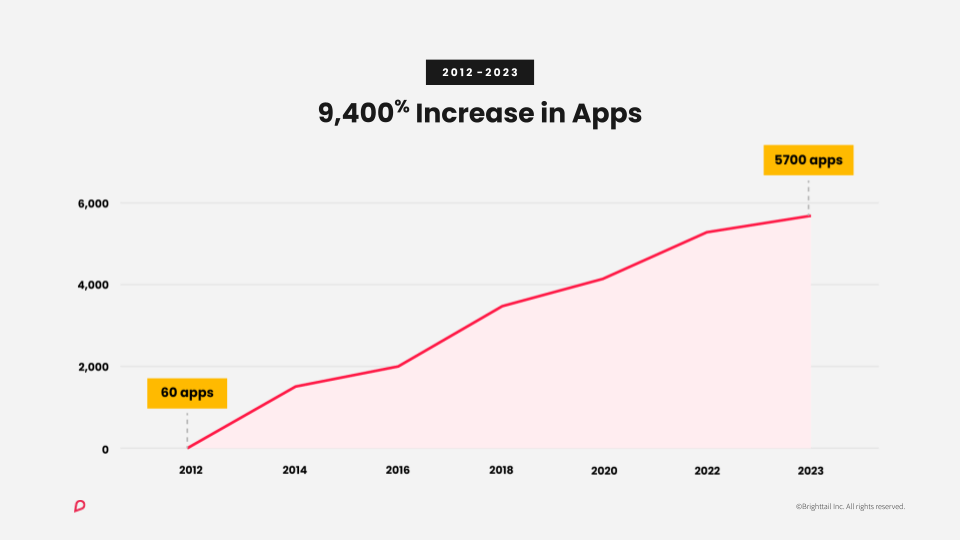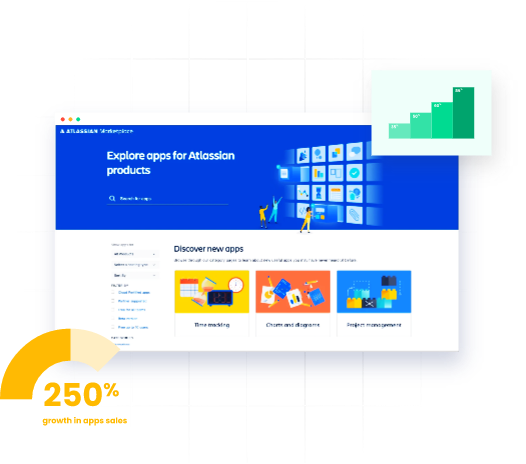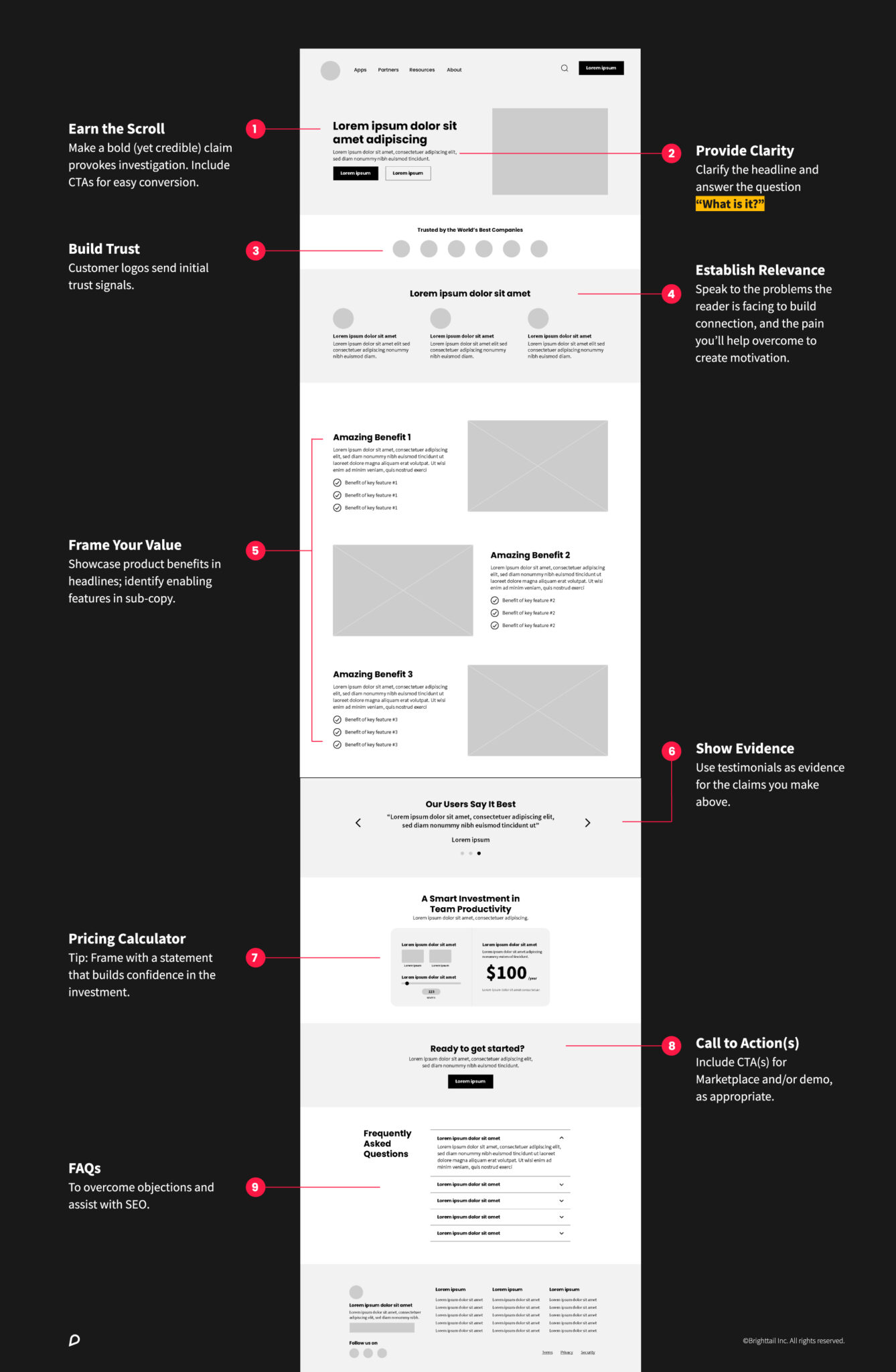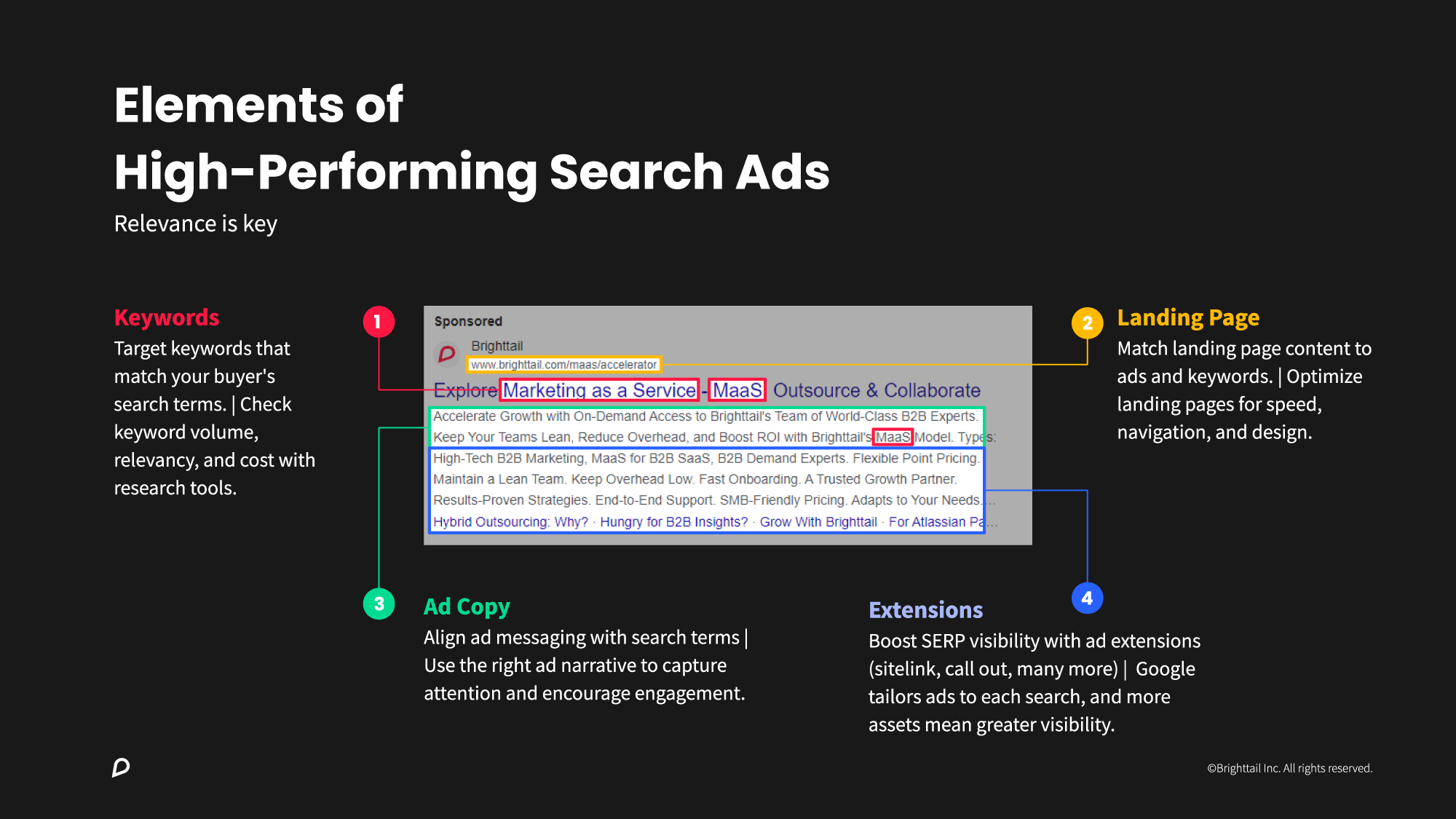The New World of App Marketing
The app marketplace has changed significantly over the past decade. Initially, it was a developer’s dream—a relatively open space where a well-built app could easily attract attention and users. However, as the number of apps grew exponentially, the landscape became more competitive.

The explosive growth in the number of apps has created a highly saturated marketplace – it is much harder for new and existing apps to stand out and attract customers. The initial ease of gaining organic growth through simple app listings and word-of-mouth has diminished.
In my discussions with Marketplace partners, I’ve learned that many are overdependent on organic growth, believing that ‘if you build it, they will come.’ But what worked a decade ago (or even 5 years ago), no longer works today.
Matthew Lewsadder, Founder & CEO of Brighttail
Failure to course correct by building and optimizing marketing channels may cause your app evaluations and sales flatline. That is why a solid GTM strategy is critical.
Getting Down to First Principles
In the context of marketplace app marketing, first principles are core strategies that you can directly control and optimize.
By concentrating on what can be managed and improved internally, app developers can create a more resilient marketing strategy that adapts to changes in the marketplace, overcomes external restrictions, and drives consistent, long-term success.
Here’s how you can do that in detail.
Invest in channels you can own
Marketplace restrictions often limit how apps can be marketed, such as restrictions on data collection, user interaction, and promotional activities. For example, the Atlassian Marketplace doesn’t publicly disclose the key aspects of how it ranks app listings. So, only relying on the marketplace to showcase your app is a misjudgement.

That is why it is important for you to create levers you can pull for a sustainable app growth. For instance, by investing in your own channels like websites, blogs, and email lists, you can bypass these restrictions, maintain control over your marketing efforts, and build a direct relationship with your audience.
Build champions, not customers
While generating leads and closing sales are critical, the goal should be to build lasting relationships with your customers. Provide continuous value at every stage of the customer journey—from pre-sales and onboarding to post-sales support and customer advocacy.
Look beyond leads, evaluations, and sales. When you truly care about your app users’ experience, you will be inclined to provide educational content, personalized recommendations, and exceptional customer service to your customers – that is how customers become product champions.
Know your numbers, and their limits
Accurate tracking and attribution systems help you understand the effectiveness of your marketing efforts, allowing you to allocate resources more efficiently and make informed decisions.
But tracking tools have limitations too. Last-click attribution, for instance, may not give a full picture of the customer journey. Regulations like GDPR and the end of third-party cookies pose challenges to data collection.
So, use data as a guide to inform your decisions, but do not let it solely dictate your strategy.
Building a High-Converting Listing
Here are two examples of timetracker app listings on the Atlassian Marketplace. Can you guess which one is optimized and which one is not?

A well-crafted app listing attracts and converts potential users even better because it shows how an app performs. Users can also quickly see the rating and reputation of the app vendor before they make a decision.
The key elements of a winning app listing are divided into two main sections: Above the Fold and Below the Fold.
Above the Fold
This is what the users see first when viewing an app listing. It must quickly convey what the app is, who made it, how it’s rated, and entice users to install it without requiring any scrolling.
App Name: Your app’s name is the first point of contact with potential users. It should be descriptive, memorable, and include high-traffic, descriptive keywords to enhance discoverability and convey the app’s purpose at a glance.
Tagline: The tagline appears on the search results page and should maximize available characters to highlight valuable keywords and differentiate your app. It should succinctly describe what your app does and its unique value proposition.
Hero Video: A 60- to 90-second video that vividly explains how your app improves the buyer’s life. This engaging visual content helps potential users understand the app’s benefits and functionality, encouraging them to explore further.
Key Highlights: Use headers to showcase your app’s differentiators and key benefits. Sub-copy should provide details about the features that enable these benefits. This section should quickly communicate why your app is worth considering.
Below the Fold
More Details: Provide additional information that can convince users of the app’s value. This includes social proof such as major brand endorsements, customer count, or user testimonials. Use bullet points to list extra features and use cases, and include links to relevant articles, videos, or documentation.
Media: Visual content like screenshots or infographics can effectively showcase your app’s most important capabilities. Zoom in on targeted features and consider adding explanatory copy to convey additional information. Captions and labels can further enhance understanding and appeal.
By meticulously crafting both sections of your app listing, you will create a high-converting app listing in the Atlassian Marketplace and provide potential users with a comprehensive understanding of your app’s value.
We successfully delivered 250% growth in app sales for our Atlassian clients.
Find out how we did it here.
Discover NowTurning Your Website into a Growth Engine
At the time of writing, there are an estimated 1.13 billion websites in existence, with around 201 million of those being actively maintained and used. The key point is that you do not just put up a website, you must turn it into a high-performing growth engine. A well-optimized website is a lever you can pull to attract, engage, and convert customers.
There are three elements of a high performing website: Product Pages, Content Marketing, and Search Engine Optimization (SEO).
Product Pages
According to Forbes, detailed product pages are crucial, with 88% of customers saying they are important for purchasing decisions.
Unlike the restrictive marketplace listings, product pages on your website give complete control over the content, design, and user experience. They are the best destination for top-of-funnel (TOFU) and middle-of-funnel (MOFU) buyers. You get to create messaging and content that wins the decision before users are redirected to your listing to purchase the apps.
And just like the app listing, a product page also has its own key elements:
Leave the product page creation to us.
Our growth-driven design and custom WordPress development will give you a growth engine that can go toe-to-toe with your competitors.
Explore NowContent Marketing
Content marketing is a powerful strategy to drive organic traffic to your website. With it, you can dramatically increase your organic traffic and build an audience that you can nurture through email, social media, and retargeting ads.

Search Engine Optimization (SEO)
Your website is your most effective weapon in the battle for search dominance. With a robust SEO strategy, you can secure your position at the top of search engine rankings, expand your portfolio of ranked keywords, and get discovered by your audience earlier in their buying journey.
A well-executed SEO strategy involves several key components which are keyword research, backlink building, content optimization, technical SEO, and on-page SEO.
Capturing High-Intent Buyers
Research shows that 71% of B2B buyers begin their buying journey with a generic search on Google.
Search ads are a powerful tool for capturing high-intent buyers. They enable you to close the gap in organic performance by appearing prominently in search results, thereby increasing visibility. By targeting buyers who have a defined need and are ready to make a purchase, search ads can capture their attention precisely when they are most likely to convert.
3 Signals of Active Buying Intent
Aligning your ad copy with buyer intent can maximize the effectiveness of your search ads. By focusing on three signals of active buying intent—your brand and product keywords, competitor brand and product keywords, and use case keywords—you can ensure your ads are relevant and appealing to potential buyers.
For instance, targeting use case keywords like “jira worklog report” for a time-tracking app helps you reach users who are specifically searching for solutions that your app provides.
Elements of High-Performing Search Ads
Creating high-performing search ads requires attention to several key elements:
Keywords: Target keywords that match your buyer’s search terms. Use research tools to check keyword volume, relevance, and cost so that you’re focusing on the most effective terms.
Landing Page: Match landing page content to your ads and keywords. Optimize these pages for speed, navigation, and design to provide a seamless user experience and improve conversion rates.
Ad Copy: Align ad messaging with search terms to highlight the unique value of your app and prompt users to take action.
Extensions: Boost visibility on the search engine results page (SERP) with ad extensions, such as sitelinks and callouts. Google tailors ads to each search, and more assets mean greater visibility, increasing the chances of capturing high-intent buyers.
Creating Demand and Winning New Audiences
Research from the Ehrenberg-Bass Institute for Marketing Science found that at any given time only 5% of potential buyers are actively in the market. The other 95% is inactive–unaware of or resistant to change.
In the realm of marketing, you must distinguish between demand creation and demand capture because they are two distinct but complementary strategies for generating business growth. While the former creates a new strategic narrative that makes a compelling case for change, the latter converts that into actual sales and revenue.
| Demand Creation | Demand Capture |
|---|---|
| Targets audiences who donʼt know about their problems and solutions | Targets audiences who are already of their problems and solutions |
| Engages 95% of the total addressable market | Focuses on only 5% of the total addressable market |
| Aims to raise awareness of a problem and create urgency for a new solution | Aims to drive awareness and interest in your specific solution |
The tactics for effective demand creation and capture are also different as shown below:

As a B2B brand, you cannot afford to keep battling it out over the same 5% of buyers who are in-market.
We can reframe how your audiences think about their world—and your brand—to unlock new opportunities for your business.
Discover NowClosing the Conversion Gap
The conversion gap is the disconnect between generating interest and driving actual conversions. Addressing this gap is an important part of optimizing the customer journey and driving business growth. You can close the conversion gap through retargeting.
Retargeting 101

Retargeting is a powerful strategy to boost app evaluations and sales by re-engaging users who have already interacted with your app or website. These users have shown interest but may need additional touchpoints to convert. By serving tailored ads to this audience, you keep your app top of mind and encourage them to take the next step in their buying journey.
Some tips for successful retargeting campaign are:
- Even if you’re not running ads immediately, set up retargeting audiences on Google Analytics and all ad platforms. This helps you build a comprehensive list of potential targets.
- Create retargeting audiences based on time-based cohorts (e.g., 30 days, 90 days, 180 days). This allows you to tailor your messaging to how recently a user interacted with your app or website.
- Ensure a steady influx of new users to expand your retargeting audience. This keeps your campaigns dynamic and prevents stagnation.
- Run different ads for each retargeting audience segment. Test various messages, formats, and creatives to see what resonates best with each group.
Effectively closing this gap leads to more efficient use of marketing resources and a higher return on investment.
Build a Killer GTM Plan with Brighttail
If you’re looking to take your marketplace app to the next level, it’s time to build a killer GTM plan. Our proven strategies will help you craft high-converting app listings, transform your website into a growth engine, capture active buyers through targeted search ads, create demand with compelling campaigns, and maximize conversions through effective retargeting techniques.
Don’t let your app get lost in the crowded marketplace. Reach out to Brighttail and let us help you improve your app evaluations and sales. With our expertise and GTM strategy, you’ll stand out from the competition and achieve sustainable app growth.







